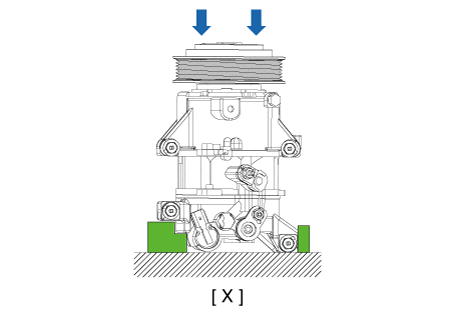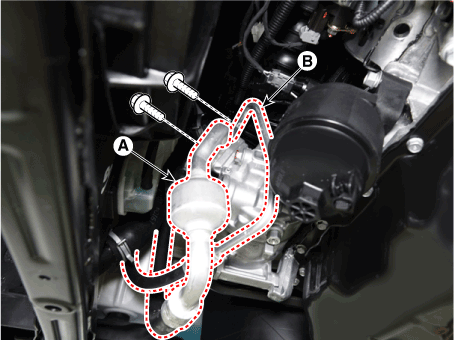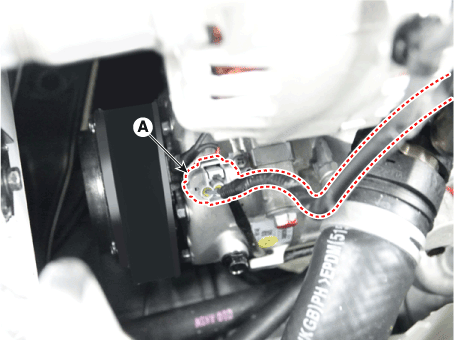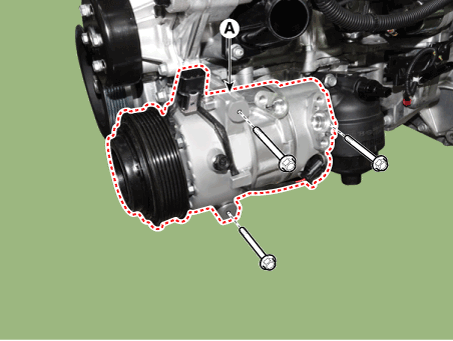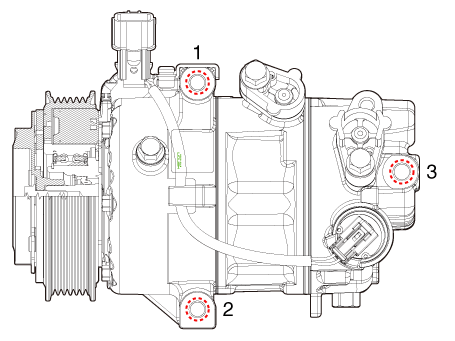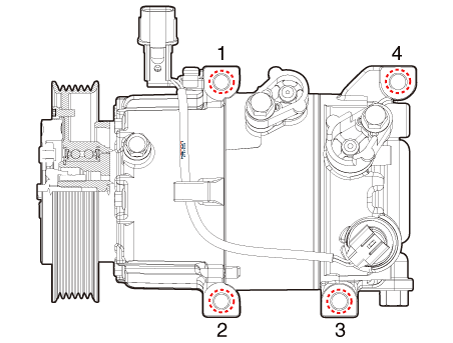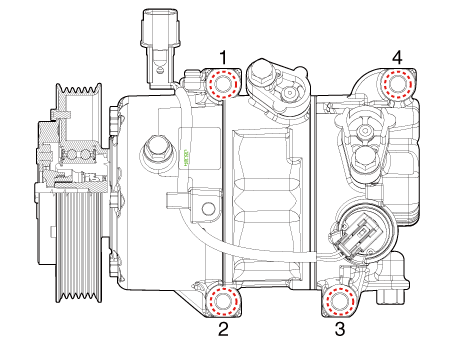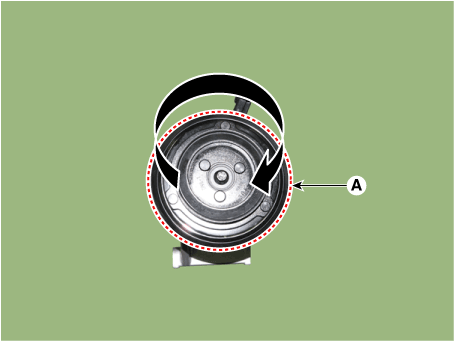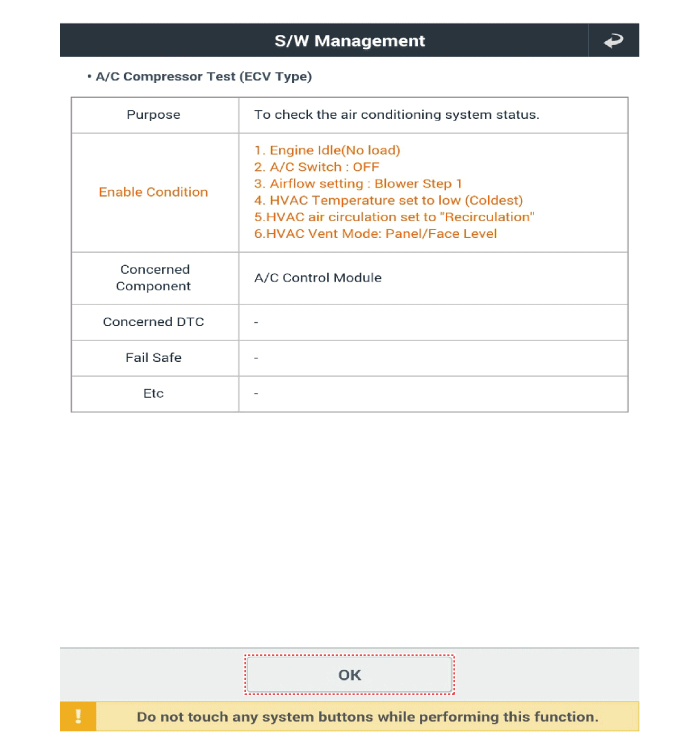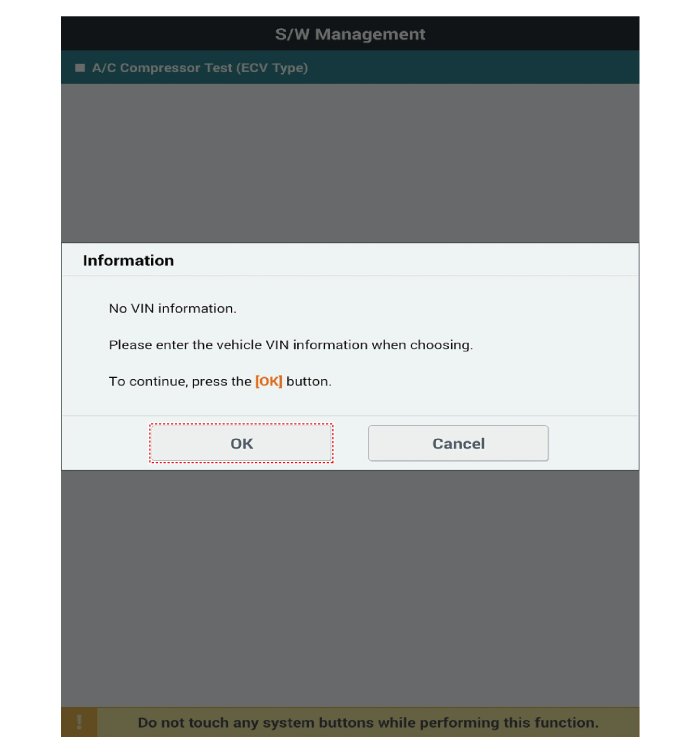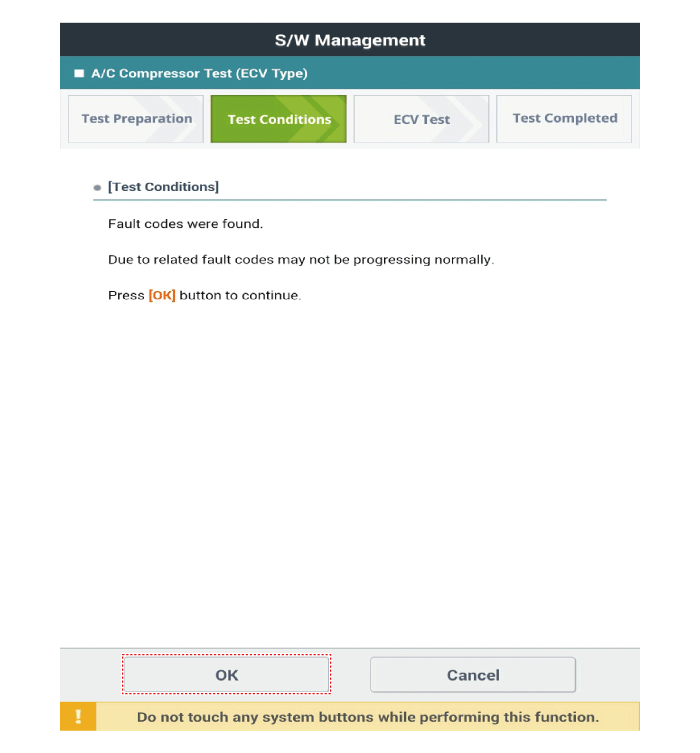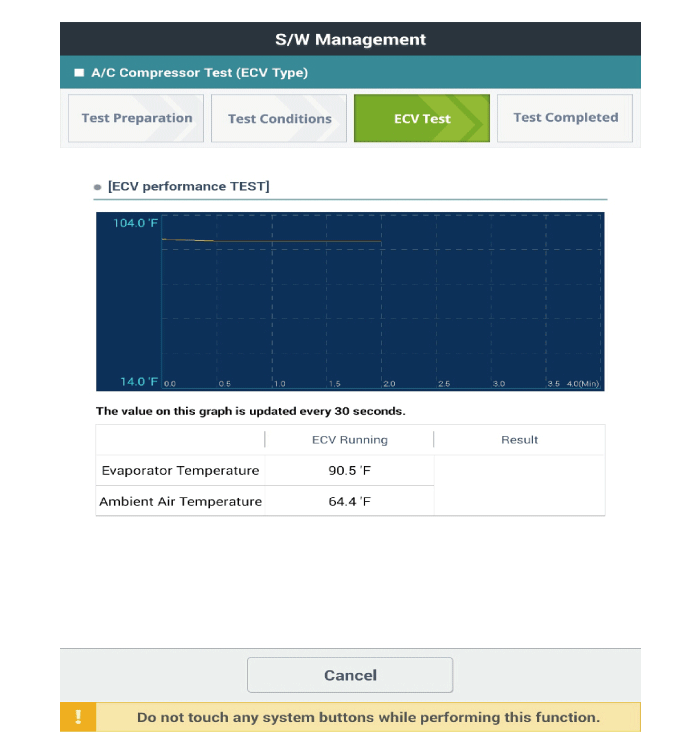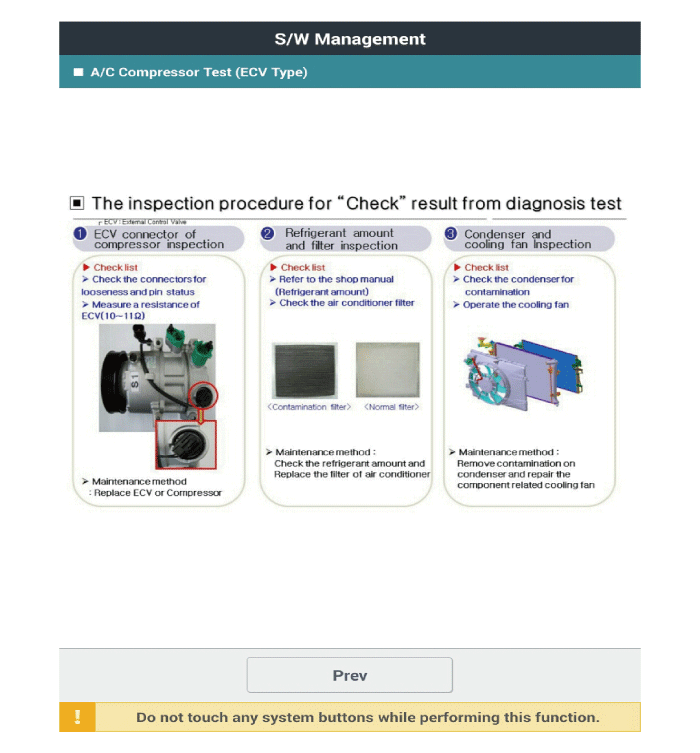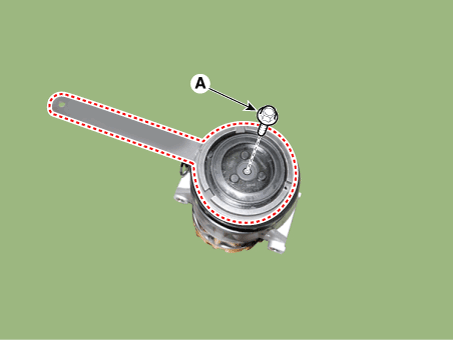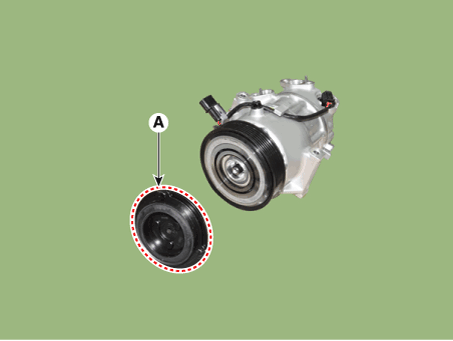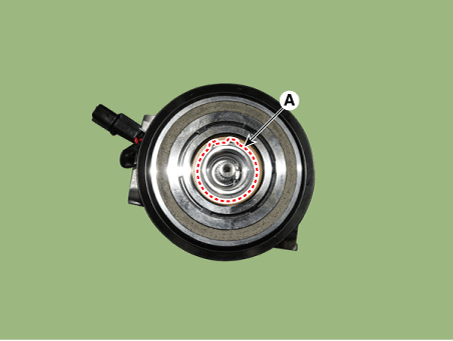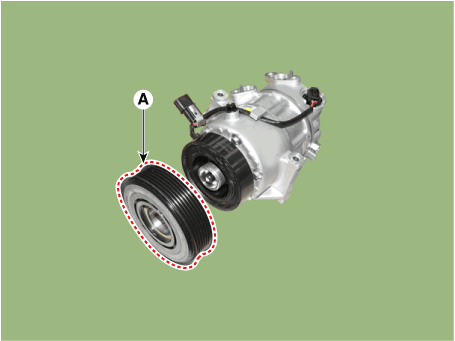Hyundai Elantra: Air Conditioning System / Compressor
Description and operation
| Description |
The compressor is the power unit of the A/C system.
It is located on the side of engine block and driven by a V-belt of the engine.
The compressor changes low pressure and low temperature refrigerant gas into high pressure and high temperature refrigerant gas.
Variable Swash Plate Compressor
The compressor has a swash plate that rotates to reciprocate pistons, which compress refrigerant.
The variable swash plate compressor controls the swash plate angle to change the refrigerant displacement. It achieves precise cooling capability control in accordance with vehicle interior and driving conditions.
The externally controlled variable swash plate compressor changes the swash plate angle by an ECV (Electric Control Valve) in accordance with an electrical signal from the heater & A/C control unit.
This enables stable temperature control and improved driving sensation.
ECV Control Diagram
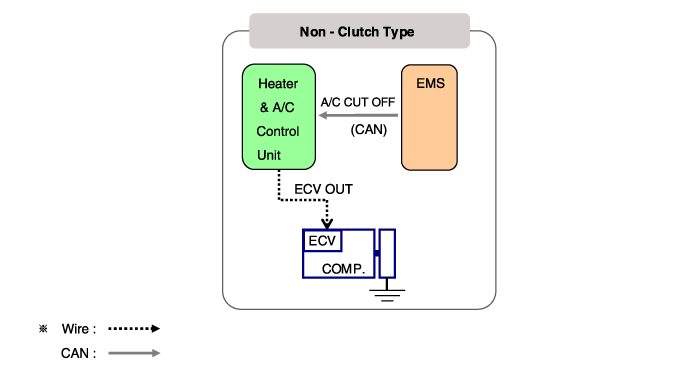
Components and components location
| Components Location |
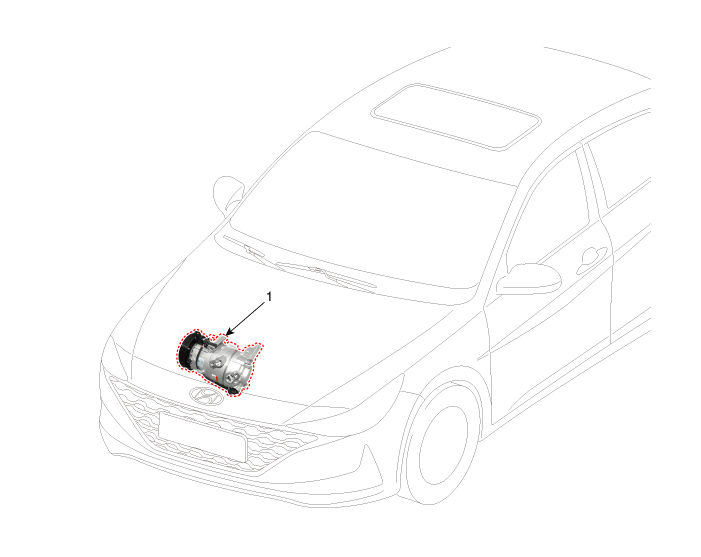
| 1. Compressor |
| Components |
[Gasoline 1.6 MPI]

| 1. Clutch bolt 2. Disc & Hub assembly 3. Air gap spacer 4. Retainer (A) 5. Pulley 6. Retainer (B) | 7. Clutch magnetic coil 8. Compressor 9. Electric Control Valve(ECV) Snap ring 10. Electric Control Valve (ECV) |
[Gasoline 1.6 T-GDI, Gasoline 2.0 MPI NU]
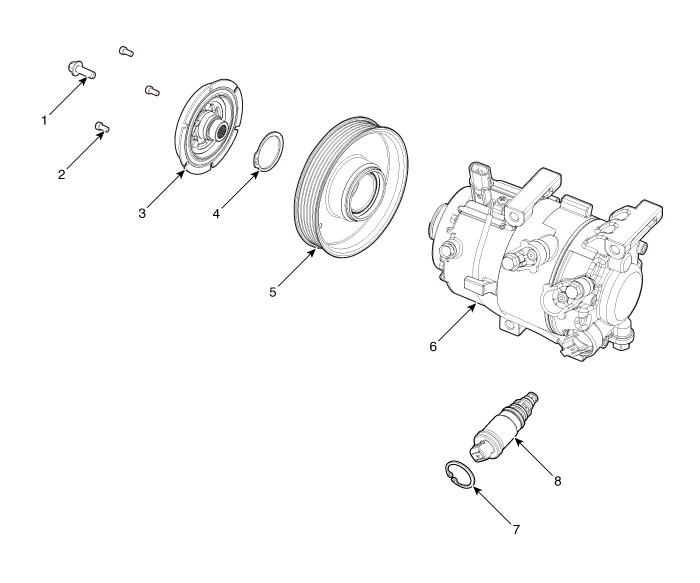
| 1. Clutch bolt 2. Limiter bolt 3. Disc & Hub assembly 4. Snap ring | 5. Pulley 6. Compressor 7. Electric Control Valve(ECV) Snap ring 8. Electric Control Valve (ECV) |
[Gamma 1.6 MPI]

| 1. Clutch bolt 2. Limiter bolt 3. Disc & Hub assembly 4. Snap ring | 5. Pulley 6. Compressor 7. Electric Control Valve(ECV) Snap ring 8. Electric Control Valve (ECV) |
Repair procedures
| Removal |
Precautions for using the plastic pulley
|
| 1. | If the compressor is marginally operable, run the engine at idle speed, and let the air conditioning work for a few minutes, then shut the engine off. |
| 2. | Disconnect the negative (-) battery terminal. |
| 3. | Recover the refrigerant with a recovery / charging station. |
| 4. | Remove the engine room under cover. (Refer to Engine Mechanical System - "Engine Room Cover") |
| 5. | Remove the front wheel guard. (Refer to Body - "Front Wheel Guard") |
| 6. | Loosen the drive belt. (Refer to Engine Mechanical System - "Drive Belt") |
| 7. | Remove the bolts, then disconnect the suction line (A) and discharge line (B) from the compressor.
|
| 8. | Disconnect the compressor switch connector (A).
|
| 9. | Remove the compressor (A) by loosening the mounting bolts.
|
| Installation |
| 1. | Make sure the compressor mounting bolt with the correct length is screwed in. Tighten the mounting bolts with the specified tightening order.
[Gasoline 1.6 MPI]
[Gasoline 1.6 T-GDI, Gasoline 2.0 MPI NU]
[Gamma 1.6 MPI]
|
| 2. | To install, reverse the removal procedure.
|
| Inspection |
| 1. | Check the plated parts of the limiter & hub assembly for color changes, peeling or other damage. If there is damage, replace the assembly. |
| 2. | Check the pulley (A) bearing play and drag by rotating the pulley by hand. Replace the pulley with a new one if it is noisy or has excessive play / drag.
|
| External Control Valve Compressor Inspection (Diagnostic tool) |
Compressor type: Fixed type compressor, External control valve, Internal control valve.
In cases of fixed type and internal control valve, it is possible to inspect compressor's operation with clutch noise.
When it comes to External control valve, however, it cannot be checked in this way bacause it doesn't have a clutch.
So, ECV should be inspected with diagnostic tool as below.
| 1. | Connect diagnostic tool to the vehicle and select 'Aircon Compressor Test(ECV type)' [ECV1]
|
| 2. | Make the vehicle ready as the diagnostic tool instruction on the monitor. (Turn off A/C 'switch' only)
|
| 3. | Check if other DTC codes are found before inspect ECV compressor. If so, solve that problems first. If not, press 'OK' button to continue.
|
| 4. | Start inspection
|
| 5. | Check the result of inspection. [ECV7]
[ECV8]
|
| 6. | If the result shows "Check" , click "Check" and follow the instruction.
|
| 7. | Inspect ECV again from the first step. |
| Disassembly |
| 1. | Remove the engine room under cover. (Refer to Engine Mechanical System - "Engine Room Cover") |
| 2. | Remove the front wheel guard. (Refer to Body - "Front Wheel Guard") |
| 3. | Loosen the drive belt. (Refer to Engine Mechanical System - "Drive Belt") |
| 4. | Remove the clutch bolt (A) while holding the pulley with a clutch bolt remover (09977-3R000).
|
| 5. | Remove the disc & hub assembly (A).
|
| 6. | Remove the snap ring (A) with a snap ring plier.
|
| 7. | Remove the pulley (A).
|
| 8. | Reassemble in the reverse order of disassembly.
|
 Refrigerant Line
Refrigerant Line
Components and components location
Components Location1. Refrigerant Pipe Assembly
Repair procedures
Replacement1.If the compressor is marginally operable, run the engine at idle speed, and let the air conditioning work for a few minutes, then shut the engine off...
 Condenser
Condenser
Components and components location
Components Location[General type]1. Condenser[N Line]1. Condenser
Repair procedures
Inspection1.Check the condenser fins for clogging and damage...
Other information:
Hyundai Elantra (CN7) 2021-2025 Owner's Manual: Maintenance Services
You should exercise the utmost care to prevent damage to your vehicle and injury to yourself whenever performing any maintenance or inspection procedures. We recommend you have your vehicle maintained and repaired by an authorized HYUNDAI dealer...
Hyundai Elantra (CN7) 2021-2025 Owner's Manual: Limitations of the function
Blind-Spot Safety system may not operate normally, or the system may operate unexpectedly under the following circumstances: There is inclement weather, such as heavy snow, heavy rain, etc. The rear corner radar is covered with snow, rain, dirt, etc...
Copyright © 2025 www.helantra7.com




